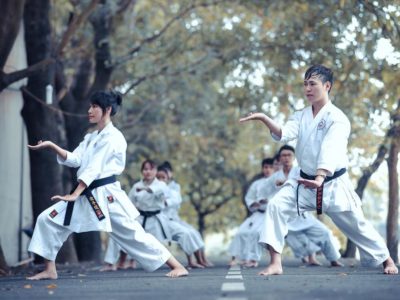Table of Contents[Hide][Show]
How to start working out at home
So, you’re finally ready to start (and stick to) a workout routine to help improve your health.
Congratulations! Getting started is the hardest part of any lifestyle change, and by doing research and simply making a decision to take the plunge, you’re already well on your way to achieving success.
When it comes to being active you have many different options to choose from, but it likely comes as no surprise that the at-home workout has boomed in popularity the last few years.
You can’t beat the convenience of getting your sweat on at home, but most people don’t exactly have access to a full-blown home gym, either.
So, how do you get started with working out at home?
First, you need to set some goals and make a workout plan. Then, you’ve got to stick to that plan and work it into your lifestyle for long-term effects and benefits.
In this post, we’re going to let you know all the basics you need to build a solid foundation for getting the best home workout.
Should you do strength training or cardio?
First thing’s first, what type of workouts should you be doing? The answer to that is going to depend on your fitness goals.
Are you looking to lose weight? Gain strength? Increase longevity? Simply feel better or improve health markers? All of these play a role, and your workout program should be tailored accordingly.
For example, if you wish to strengthen your heart and cardiovascular system, you’ll need more lung power and endurance, so more cardio training is necessary. However, if you’re trying to increase strength or build muscle mass , you’ll want to focus on more strength training.
There are fitness levels for both forms of training from low-impact exercises for beginners to more high-intensity HIIT workouts.
Regardless of your specific goals, a combination of both strength and cardio training is always a good idea. This is because incorporating both will make your fitness more well-rounded overall, leading to the prevention of disease and injury—both in the short term and the long-term.
What equipment do you need for an at-home workout?
There are plenty of exercises you can do with just your body weight alone, and you can become very fit simply from utilizing gravity against yourself in this way.
However, if you want to add some at-home workout equipment to your mix, there are a few basics that will go a long way in building your repertoire.
Those include:
- A yoga mat
- Pairs of dumbbells (5lbs, 10lbs, 15lbs, and 20lbs are all great starter weights)
- Kettlebells (15lbs, 25lbs, 35lbs are all great starter weights)
- Small exercise ankle bands
- Long exercise resistance bands (resistances vary, so starting with a 20-40lb band is great!)
- A jump rope
You don’t need to buy all of these at once. Each time you add a new piece of equipment to your collection, you’re expanding the ways you can push yourself when you work out.
But each of these accessories are extremely versatile and easy to store, so they’re a great addition to any at-home workout regimen!
Related
Physical Fitness to Get Your Gut Health in Gear
A lot can happen in 42 days. Habits form, people fall in love, zucchinis grow. And according to recent research, the bacteria in the gut microbiome changes after only 42 days — or six weeks — of exercise. That’s without changing your diet, medication, or anything else. A burgeoning field of study, the gut microbiome …
The best workouts to do at home
Here’s the thing: the “best” workouts are tailored to your goals and needs.
However, if you’re just looking to get started doing something, these next few tips are a great place to do just that.
There are 6 key movements the body makes that are crucial for building a full body workout program. Those are:
- Push
- Pull
- Squat
- Lunge
- Hinge
- Core + Carry
And, there are 3 main planes of motion that the body uses in everyday life, so it’s good to keep those in mind as well:
- Sagittal; forward and backward
- Frontal; side to side
- Transverse; anything with a twist
When you make both the planes of motion and the necessary movements as your “must do” factors of any workout, it’s going to be a good one.
By trying to include at least one of each key movement and at least one exercise in each plane of motion, you’re setting yourself up to build strength that will not only boost your health, but can also be applicable in the real world.
And don’t worry, this might sound like a lot to keep in mind at first – but the key takeaway is that you are combining these two factors (examples below).
So, in theory, you could create a workout with just one of the 6 key movements and then ensure that some of those are in the sagittal plane, some in the frontal plane, and some in the transverse plane.
Let’s get into some examples of how to put these into practice.
Examples of the 6 key body movements
Push
Any movement considered a “push” is doing what it sounds like: pushing something away from you, or in general moving your form of resistance (weights, bands, or the floor) away from the body.
If you’ve got dumbbells or any sort of weight at home, this could include exercises such as:
And if you’re just working with bodyweight or bands, you can get this motion into your routine with:
- Push-ups
- Band presses (chest or shoulders)
- Step-ups
All these examples are in the sagittal plane because they are moving you forward and backward. We’ll cover examples of how to reconfigure them into frontal and transverse movements in the next section.
Pull
“Pull” movements follow the same logic as push: any movement that involves you pulling the resistance toward your body.
Some pull movement examples with weights include:
- Dumbbell or barbell rows
- Hamstring curls
- Lat pull-downs
And some pull movements that can be done with bands or bodyweight include:
It’s important to include pull movements in most workouts, because it helps to bring balance and correct body imbalances stemming from how most of us in the western world work.
Many people today suffer from lower back pain and / or slumped shoulders, due to how much we sit (at our desks, lounging after work, etc).
By making sure there are pull exercises in your workout, especially for your upper body, you are working to add much-needed strength to your back muscles so that your posture can improve to support better mobility as you age.
Squat
You can probably guess where this one is going! A squat movement is anything that mimics – you guessed it – a squat. Picture this like the “proper” way we should be sitting back into a chair.
Some squat motions that can be done with or without weights include:
This movement is considered one of the most crucial because it is a major factor in how we walk and move through the world.
If your squats are neglected, you are much more likely to experience mobility issues as you age.
Lunge
Lunges get their own category even though they are like squats because they are one-sided movements.
These lunge examples will start to give you an idea of how the 3 planes of motion work in, too, because most lunge variations are in the frontal or transverse planes.
Some lunge examples include:
- Standard step-forward or walking lunges
- Step-back lunges (better if your knees are sensitive!)
- Sideways lunges
- Curtsey lunges
- Jumping lunges
The sideways lunges are in the frontal plane, and the curtsey lunges count as transverse because one leg crosses behind the other for this movement.
In the same way, the other motions we’ve covered can be tweaked into other planes of motion…more on that soon.
Hinge
No, we’re not talking about the dating app here! A hinge motion is anything that involves the bending motion at your hips, the bend that separates your upper and lower body.
For example, some hinge movements include:
All these movements train the hips and gluteus muscles to better support the bending and straightening of your hips, and the separate motions of the upper and lower body.
Hinges are also considered incredibly important for longevity and mobility.
Have you ever seen someone limping, or unable to bend down and pick something up off the floor? This is because they don’t have good upper/lower body separation of movement, and likely weak hinge muscles.
Supporting the strength of these muscles and the ability for the body to separate upper and lower body movement is necessary for good movement as we age.
Core + Carry movements
Some coaches might omit the core part of this last key movement but supporting the spine with our muscles attached to it is important to prevent injury and back pain.
“Carry” movements sound like what they are: anything that involves you carrying a resistance.
And oftentimes, just carrying resistance does strengthen your core by default.
The most common carry movement is called a farmer’s carry, and you can alter this in many ways:
- One-sided
- Overhead
- Varying weights on each side
- Change the direction of movement
And some core exercises that can be done anywhere include:
- Plank (and its hundred of variations)
- Sit ups
- Leg raises
- Bird dog
- Dead bug
- Burpees
- Crunches
- Mountain climbers
There are hundreds of different core exercises to choose from – and the few listed here have many variations of themselves.
When it comes to any of the 6 key movements, keep in mind that there are many exercises that can be done in these categories.
Those listed here are some of the most common ones – searching the names of any of these movements online will result in plenty of “how-to” videos to get your form right when you start!
Just pick one exercise from each of the key movement categories, and you’ve got a well-rounded and functional workout to do at home.
Now, last thing: how do you add the element of the 3 planes of motion to these 6 key movements?
Working out in 3 planes of motion
Let’s take the example of picking one exercise from each of the 6 key movements.
For simplicity, let’s choose the following movements that can be done at-home with no equipment:
- Push-up
- Pull-up
- Squat
- Lunge
- Single-leg balance reach
- Plank
All of these movements in their classic form are in the sagittal plane. But you can easily mold some of them to the other planes.
Instead of a regular lunge, you can do a clock lunge. Instead of a plank, you could do side planks.
Just by slightly changing those two exercises, you’ve now created a triplanar workout that hits all of the 6 key movements for long-term mobility, and it can be done anywhere.
Final Thoughts
Starting a workout program isn’t as hard as it sounds, but changing your schedule and committing to that new thing on your checklist can be.
Make sure your mindset is right and that you’ve made it as easy as possible for you not to find reasons to skip the workout.
A great way to do this is to block out your workout time like it’s a doctor’s appointment or meeting for work. Act like it’s an essential part of your day, because it is!
Once that is set, you can use the template in this article to build yourself a total body workout that can be done anywhere without any fancy gym equipment.
Just remember: 6 key movements + 3 planes of motion = a well-rounded and functional workout. Hit at least one of each key movement, and make sure you cover the 3 planes of motion between them. Just start small at first and don’t forget to warm up and keep hydrated.
Stick to it and you’ll see and feel a difference much sooner than you may think.
You May Also Like…





